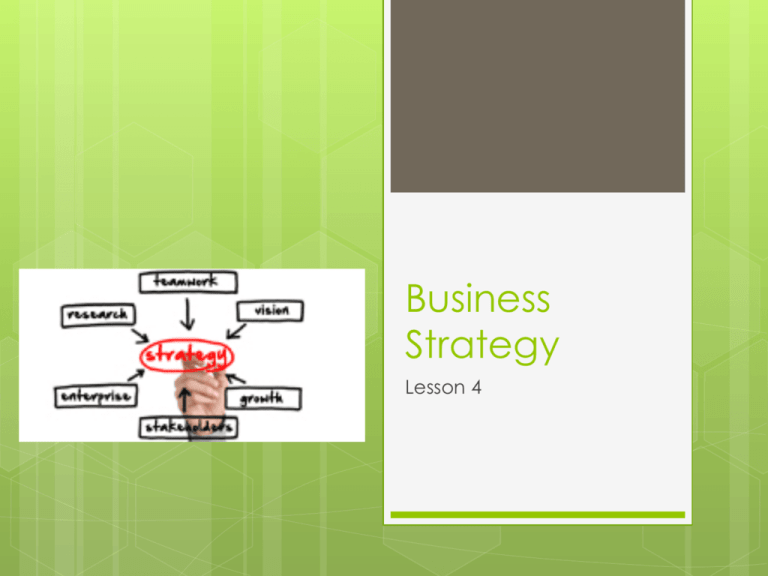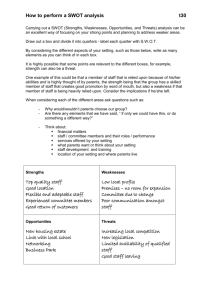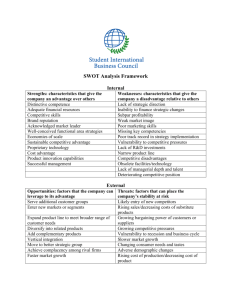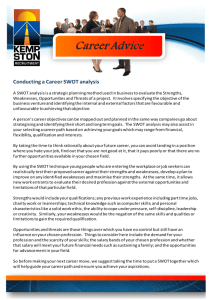Business Strategy
advertisement

Business Strategy Lesson 4 Business Strategy A business strategy is the means by which it sets out to achieve its desired ends (objectives). It can simply be described as a longterm business planning. Typically a business strategy will cover a period of about 3-5 years (sometimes even longer). Business Strategy is a long term plan of action designed to achieve a particular goal or set of goals or objectives. Strategy is management's game plan for strengthening the performance of the enterprise. It states how business should be conduct to achieve the desired goals. Without a strategy management has no roadmap to guide them. Performance Management Performance management helps organizations achieve their strategic goals. It is how your resources and people are managed to deliver your objectives. Performance management is really about good management, ensuring that your organization and team goals are achieved. It helps to: prioritize what gets done and ensure there are sufficient resources to do it ensure you provide value for money motivate and manage staff identify and rectify poor performance at an early stage learn from past performance and improve future performance increase customer satisfaction. Performance Management It is sometimes called Business Performance Management (BPM) and it helps improve: Control Coordination Communication Performance management model which involves four steps: 1. Set a Strategy 2. Create a plan 3. Monitor and Analyze utilizing Business Intelligence and Business Dashboards 4. Make Decisions and Adjustments Creating Business Strategy An essential first step in business performance management. 1. 2. 3. 4. 5. 6. 7. 8. Set a Vision Statement (future – where they want to be), Set a Mission Statement (purpose-what they do), Doing a SWOT analysis - Strengths, Weaknesses, Opportunities and Threats, Creating a Balanced Scorecard, Setting Goals/Objectives, Creating a Strategy Map, Setting Key Performance Indicators or KPIs ,and Creating Dashboards to monitor KPIs Vision Statement It describes a picture of the company's future and the direction it is headed. It encapsulates the customer focus and market position it should have. Writing a vision statement should answer the following questions: What will the business look like in 3 to 5 years from now What things you are going to try and achieve What customer needs you are going to address Ideally it should be audacious and challenging and represent your dream. It should inspire and excite. Vision Statement “Where do we want to go?” Vision statements capture your dreams and hopes for your business. It reminds you of what you are trying to build. It should act as an inspiration to all associated with the company - employees, customers and shareholders. It may apply to an entire company or to a single division of that company. The vision statement is usually short - a few sentences at most and should be memorable. Vision Statement Examples: "We bring the good things to Life" - General Electric(GE) "To enable people and businesses throughout the world realize their potential" - Microsoft "Our ability to grow, innovate and deliver superb service, combined with our tested, highly successful business model, positions us to perform well in a wide range of economic scenarios. We're looking forward to our future — the best is yet to come." - Marriott Hotels "To be the most creative organization in the world.“ - BBC vision Mission Statement It is simply a statement of company's, team's or organization's purpose. It describes what business the company is in and the customer needs it is trying to meet. The goal of mission statement is to keep you headed in the right direction when trying to plan ahead. It could be said it is the company's compass. Here are the key questions to ask to create a mission statement: Who are our customers? What market do we serve? What customers needs are you trying to satisfy? What specialist knowledge does the company hold? What specialist knowledge or competencies does the company hold? Write a mission statement that is clear, short and memorable Examples Detailed Mission Statement examples: The World's Largest Company by revenue Walmart's Mission Statement Engendering the 'Third Place’ - Starbucks Evolved from Crisis to 'Best in The World‘ Best Buy Mission To enrich people's lives with programmes and services that inform, educate and entertain. Six purposes 1. Sustaining citizenship and civil society 2. Promoting education and learning 3. Stimulating creativity and cultural excellence 4. Representing the UK, its nations, regions and communities 5. Bringing the UK to the world and the world to the UK 6. Delivering to the public the benefit of emerging communications technologies and services INDIVIDUAL ACTIVITY Name your company, define. Compose your Vision and Mission. SWOT S stands for Strengths W stands for Weaknesses O stands for Opportunities T stands for Threats SWOT analysis is an important tool for rapidly establishing the overall strategic position of a business and its environment. It is an important step in helping determine your business strategy and so lead you to your business intelligence strategy. Once key issues have been identified, they feed into business objectives, particularly marketing objectives and goals. Sometimes you can apply it to projects and other ventures. It is a very popular tool with business and marketing professionals because it is quick and easy to learn. It is subjective though and is best done by involving a good cross section of staff and external people, so that you get as complete and objective set of SWOTs. When to use SWOT The use of a SWOT analysis is to organize information, provide insight into barriers that may be present while engaging in social change processes, and identify strengths available that can be activated to counteract these barriers. A SWOT analysis can be used to: Explore new solutions to problems Identify barriers that will limit goals/objectives Decide on direction that will be most effective Reveal possibilities and limitations for change To revise plans to best navigate systems, communities, and organizations As a brainstorming and recording device as a means of communication To enhance “credibility of interpretation” to be utilized in presentation to leaders or key supporters. Strengths and weaknesses are Internal factors. People - Skills, Attitude, Training, Knowledge Products - Quality, Price, Life Cycle Operations/Production - Capacity, Flexibility Organization - Structure, Relationships Systems - Computer, Databases, Monitoring Dashboards Finance - Balance sheet, Cash Flow Reputation - Customer opinion Opportunities and Threats are External factors. Economy - Strength of Currency Market - Growth/Decline, Fashion Trend Legislation - Pollution, Product Liability, Energy, Healthcare Technology - Substitutes, New Tools, Artificial Intelligence Society - Ageing Population Environment - Recycling, Increased Testing, Protection Benefits of SWOT The SWOT analysis in Social Work practice framework is beneficial because it helps organizations decide whether or not an objective is obtainable and therefore enables organizations to set achievable goals, objectives, and steps to further the social change or community development effort. It enables organizers to take visions and produce practical and efficient outcomes in order to effect long-lasting change, and it helps organizations gather meaningful information in order to maximize their potential. Completing a SWOT analysis is a useful process regarding the consideration of key organizational priorities, such as gender and cultural diversity, and fundraising objectives. Google Website Use Google website to present your Vision, Mission and SWOT.





